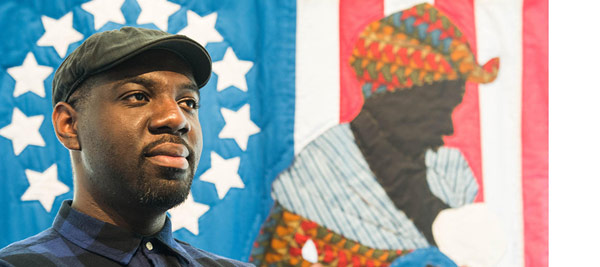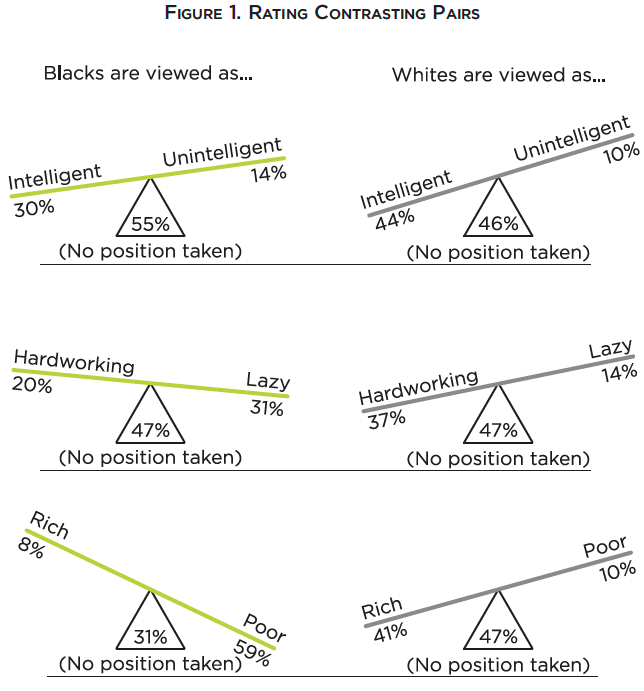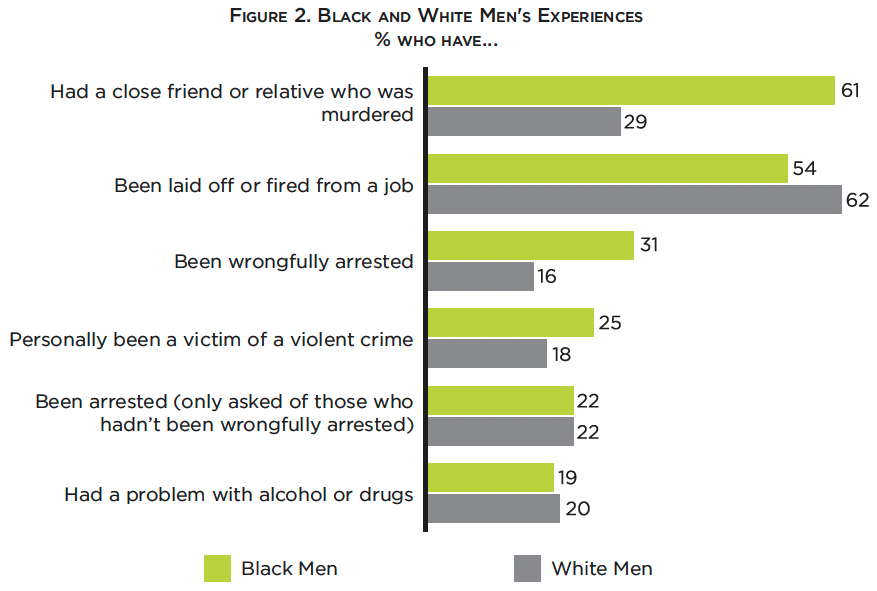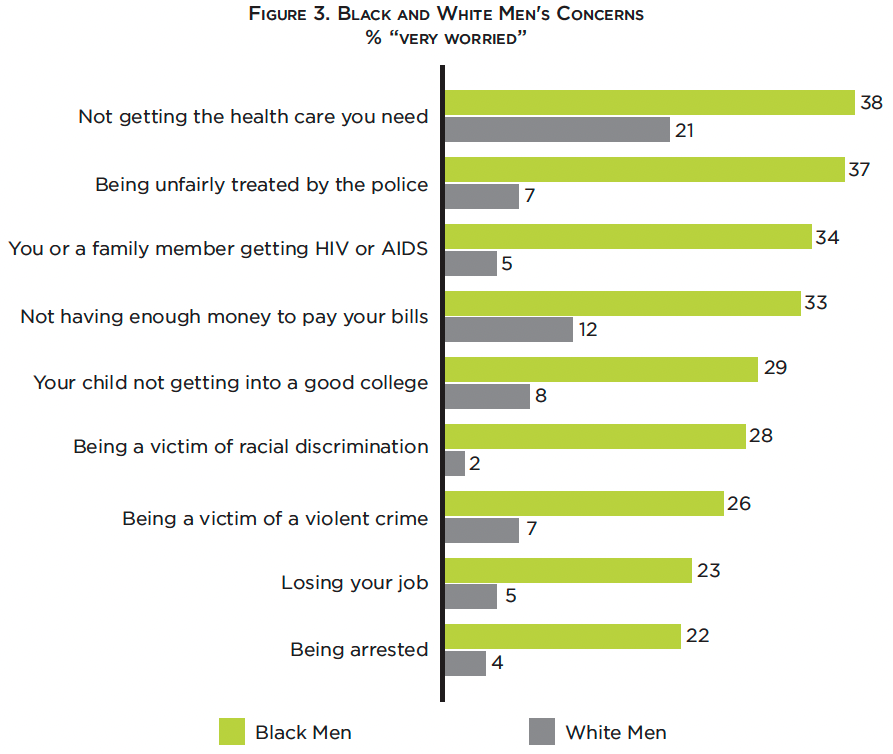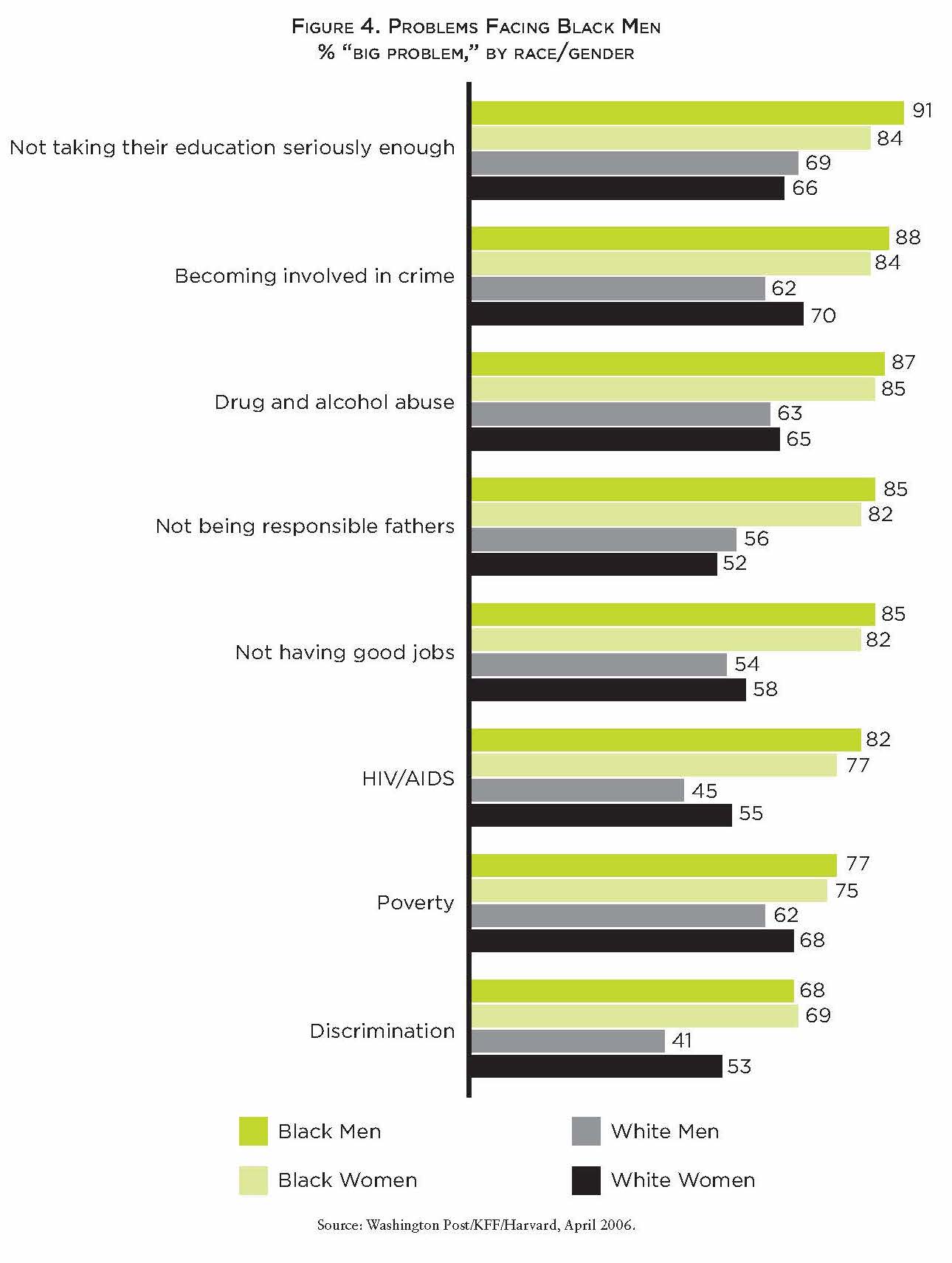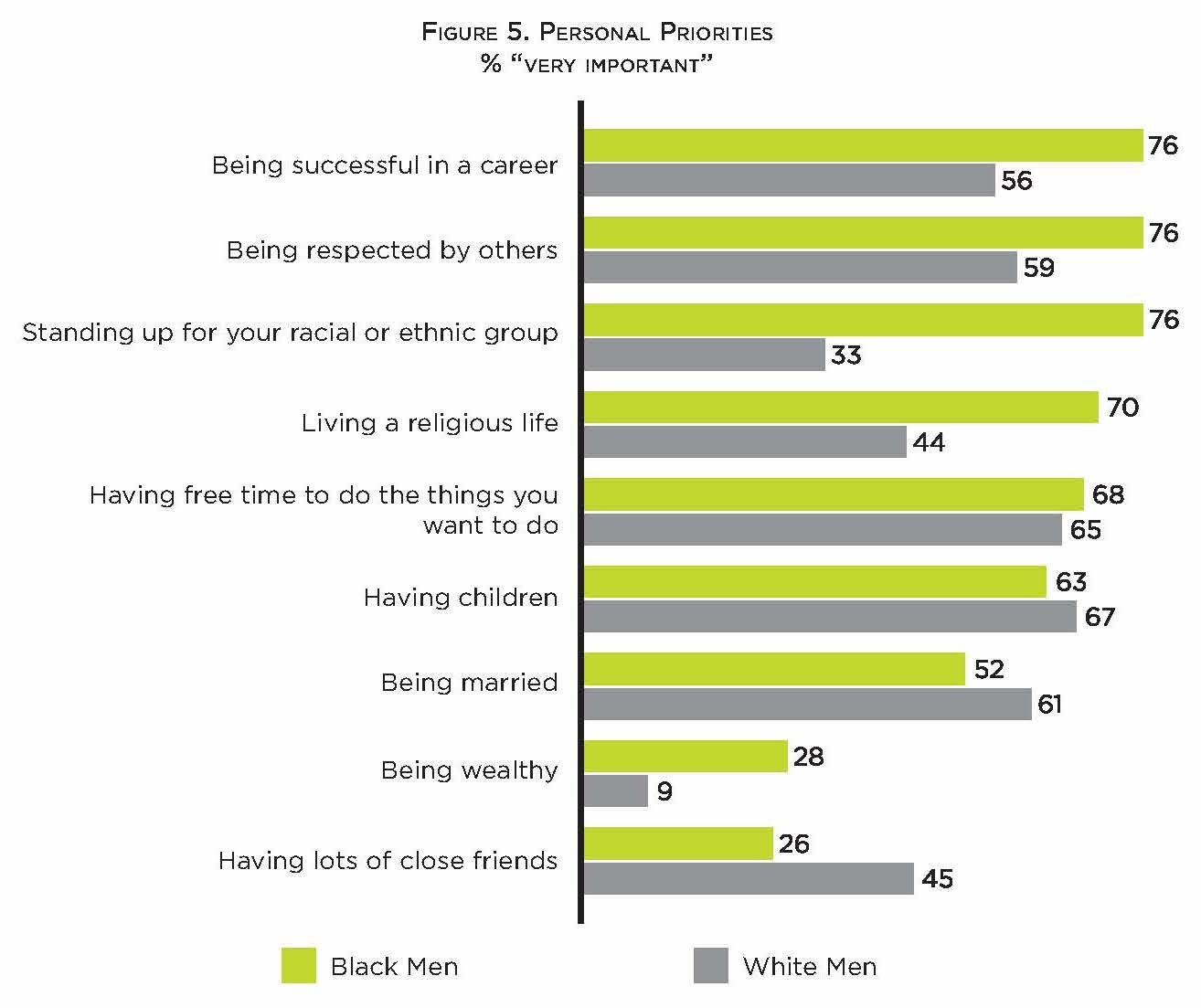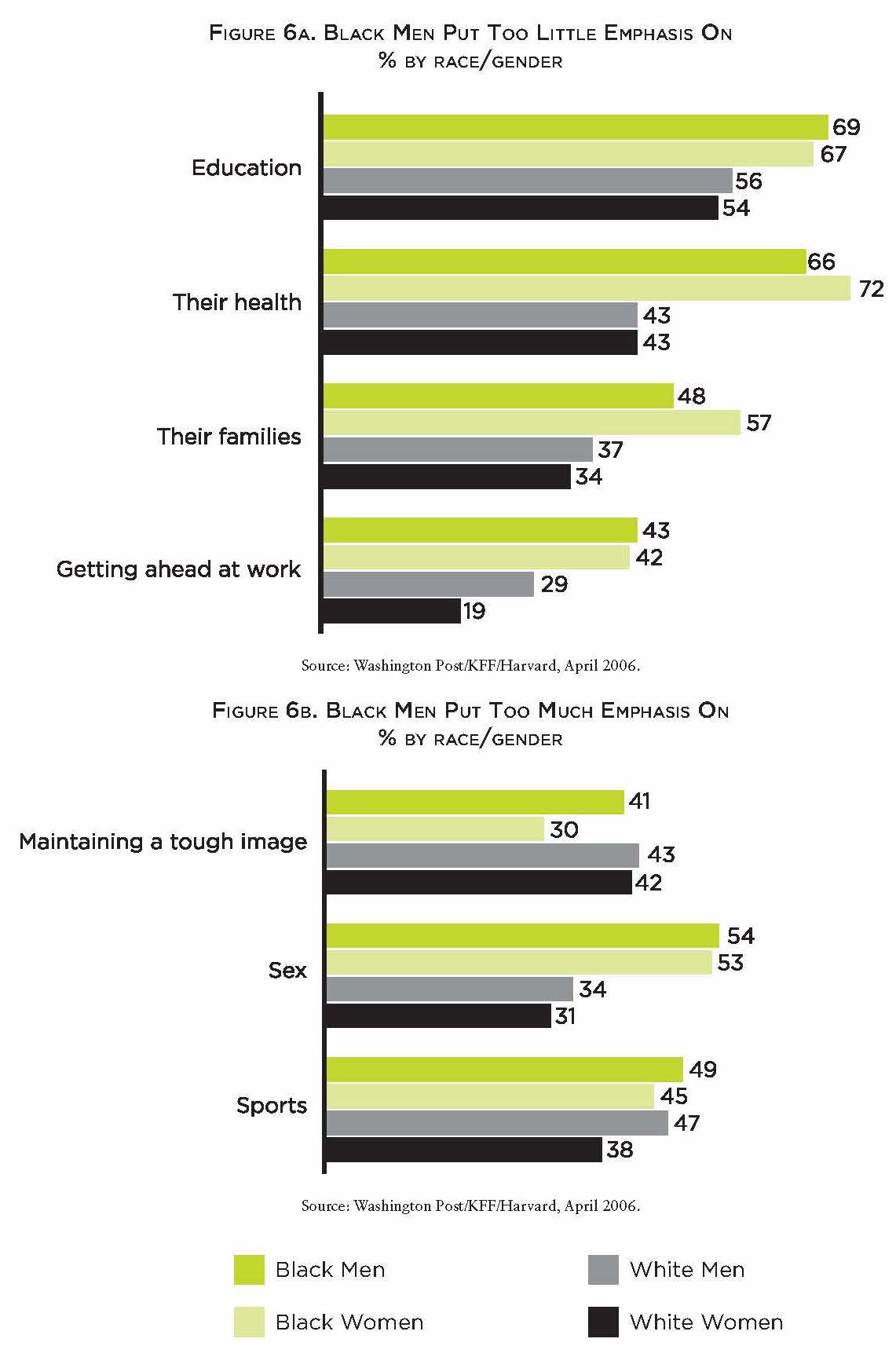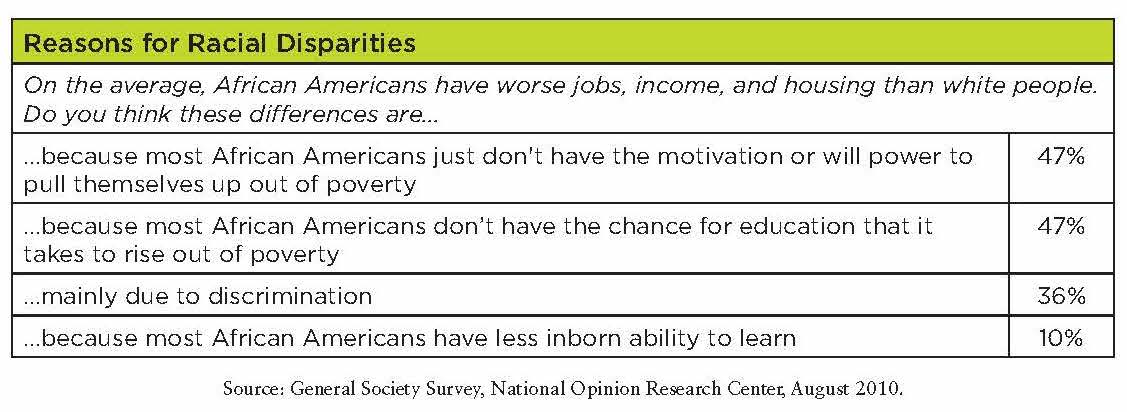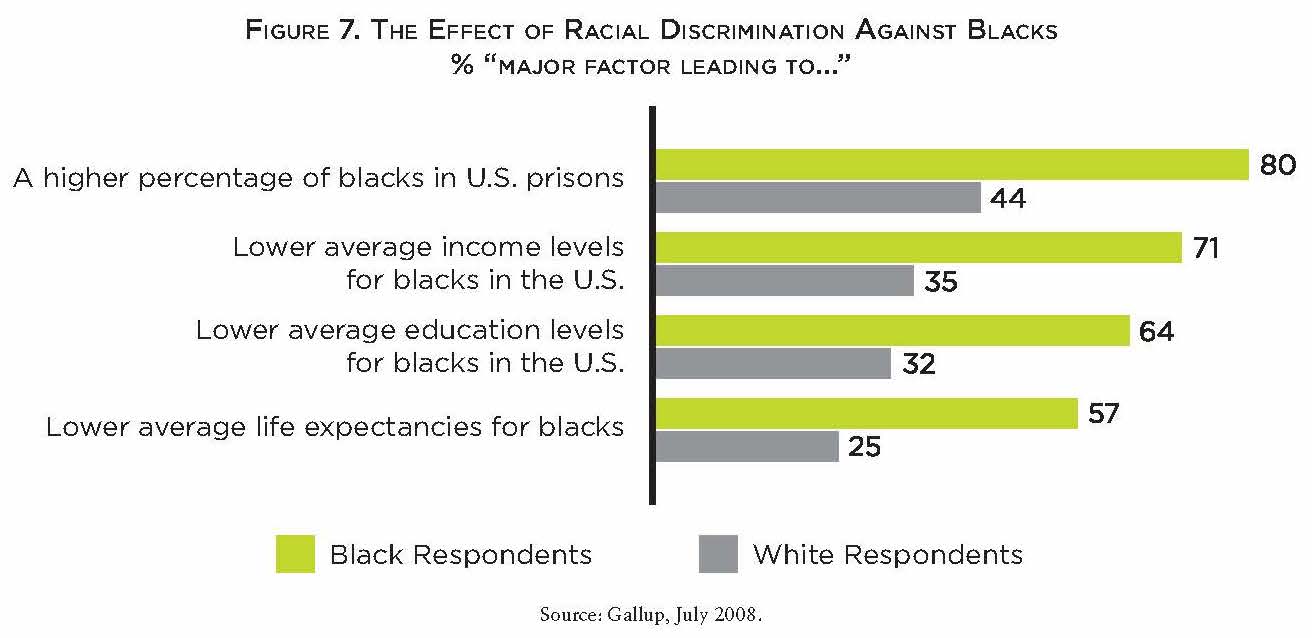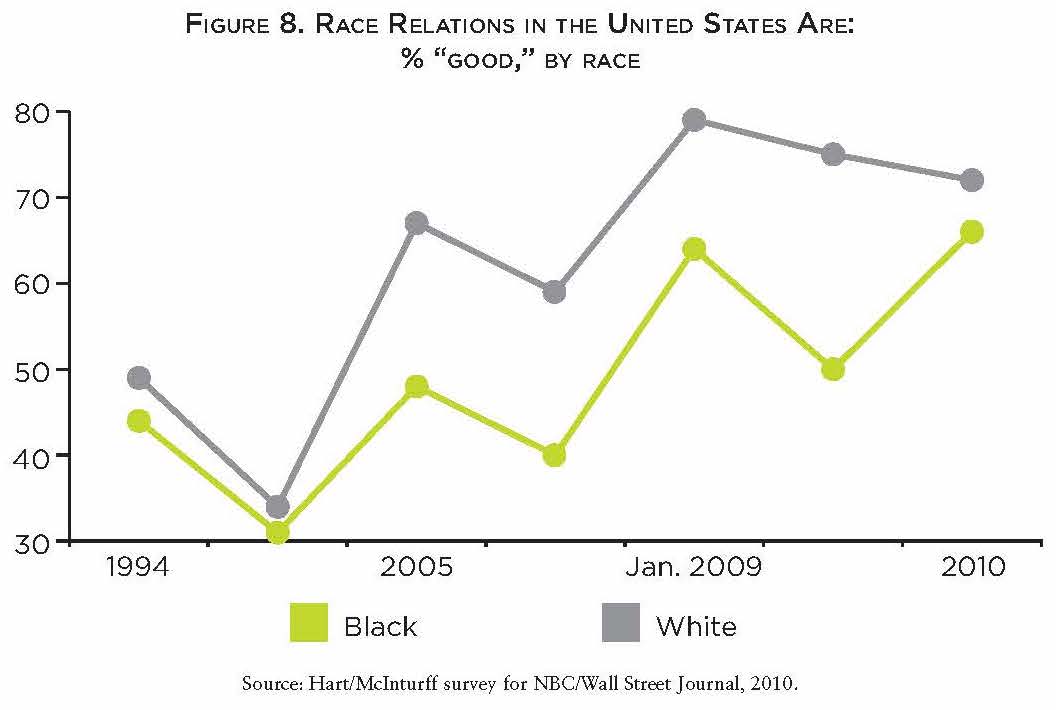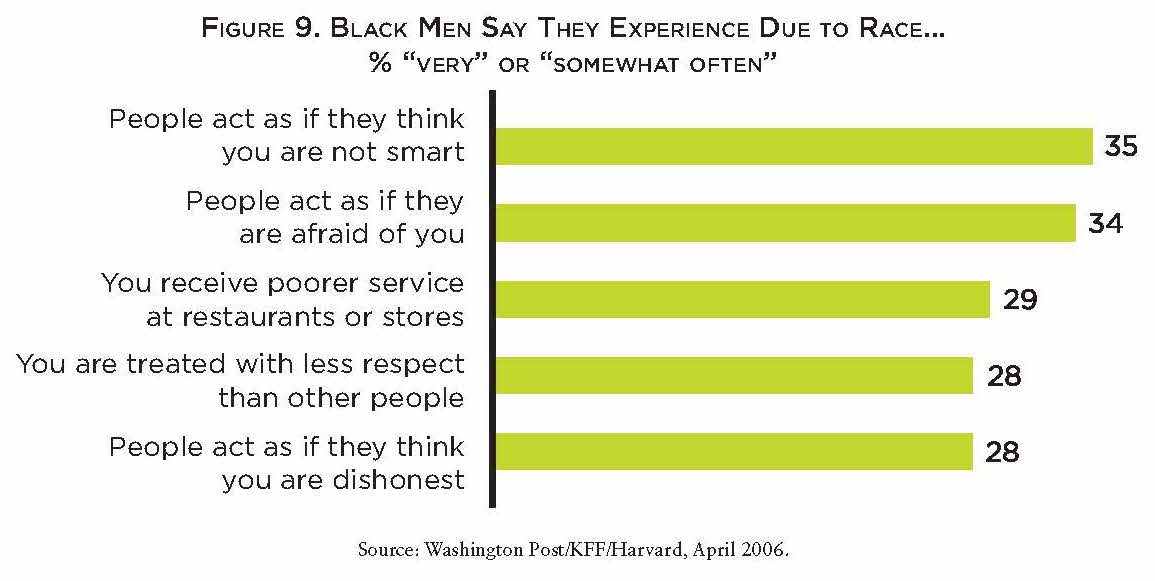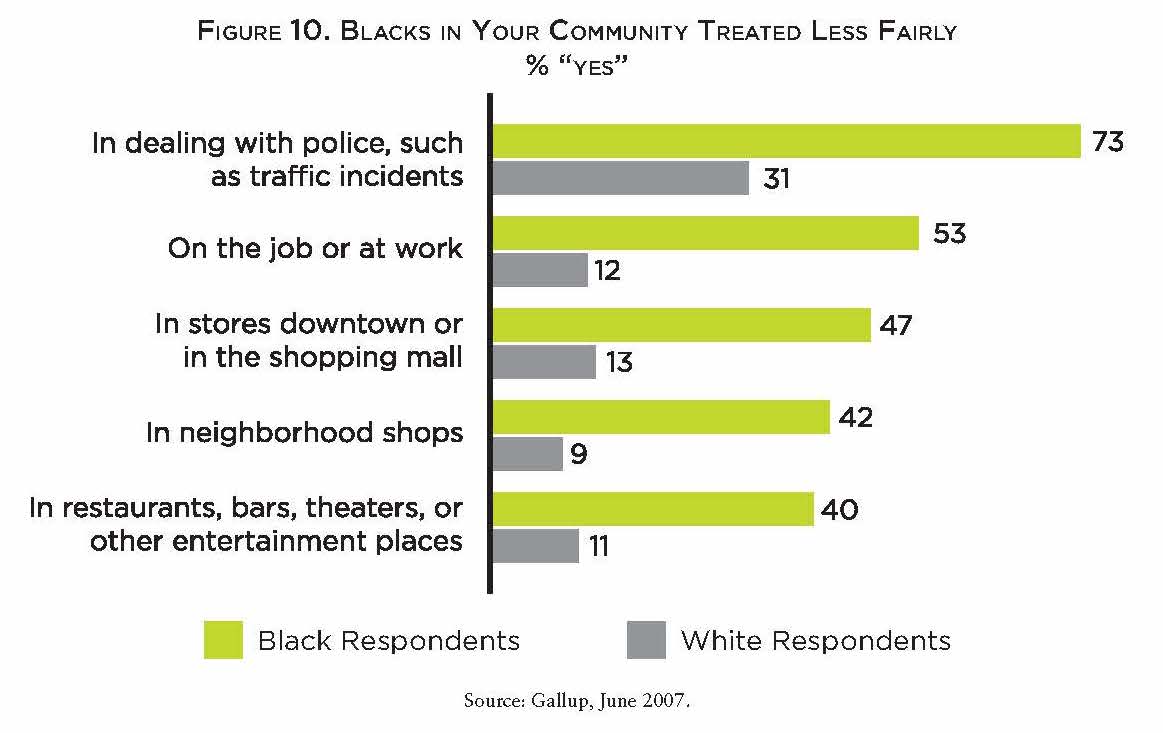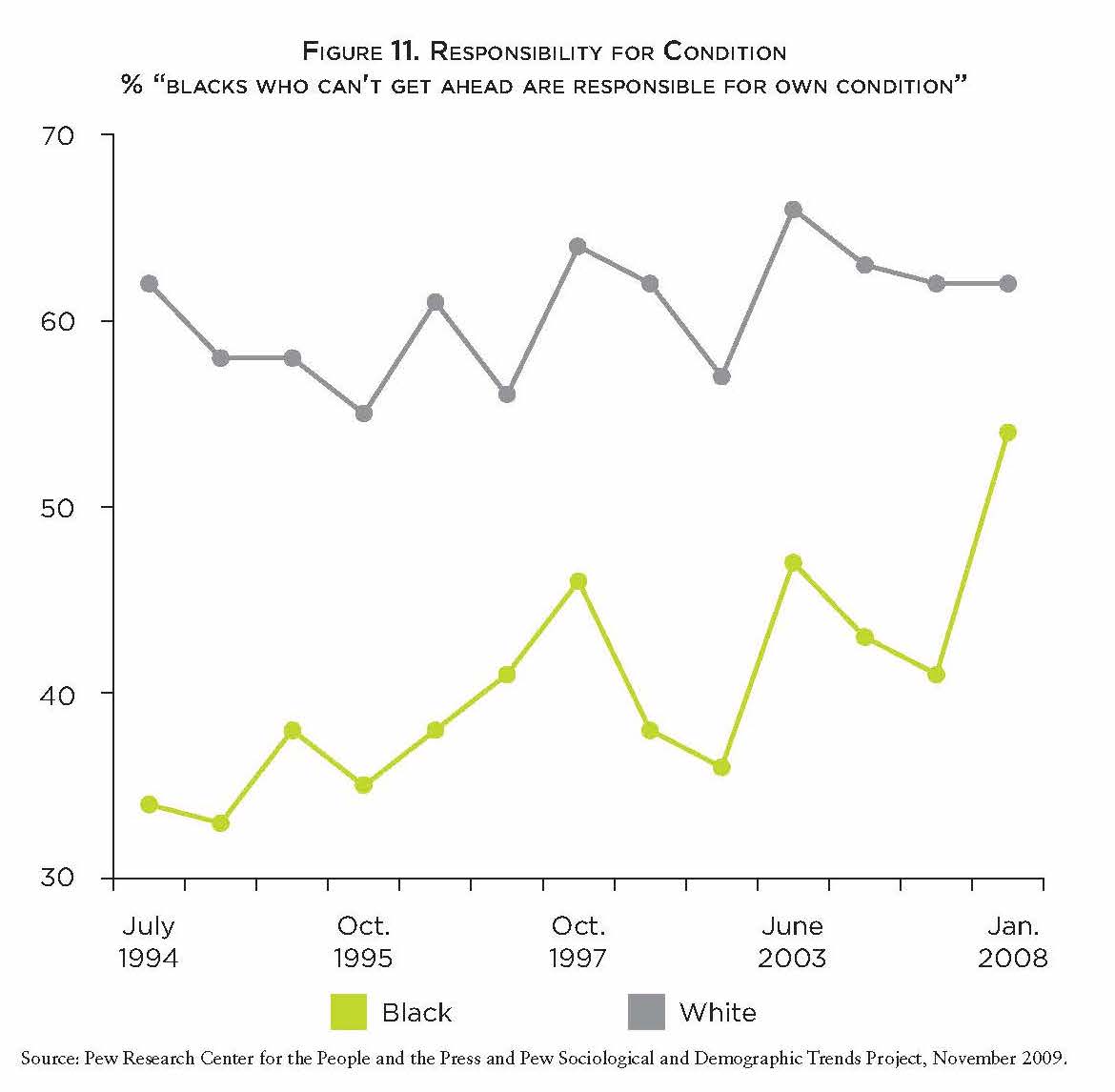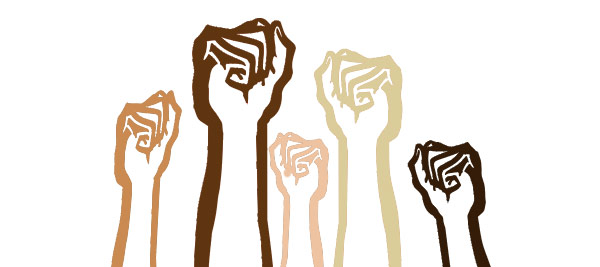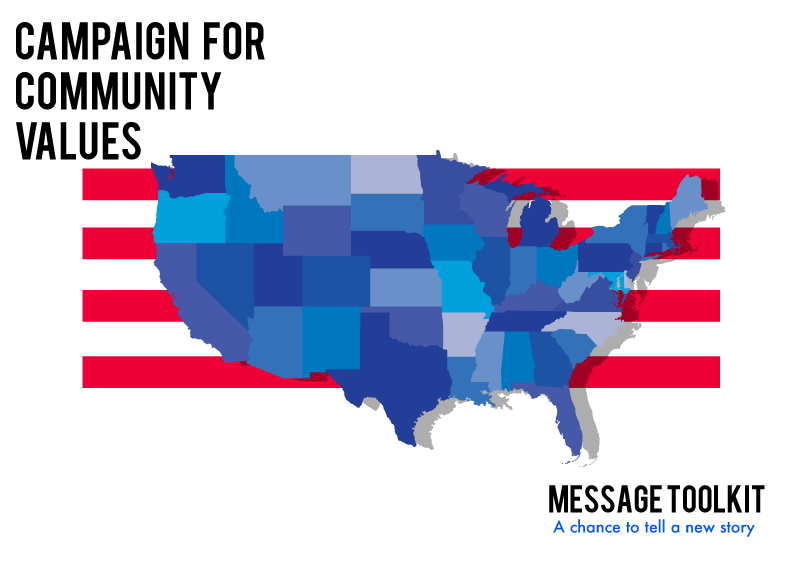Acknowledgements
This report was written by Meredith King Ledford, MPP, and reviewed by Juhu Thukral and Ross Mudrick of The Opportunity Agenda.
This report was made possible in part by a grant from The Libra Foundation. The views and opinions expressed are solely those of the report’s authors and The Opportunity Agenda.
The Opportunity Agenda would like to thank the following individuals for their invaluable comments and assistance in the preparation of the report: Algernon Austin, Ph.D., Director of the Race, Ethnicity, and the Economy Program, Economic Policy Institute; Marc Mauer, Executive Director, The Sentencing Project; and Brian Smedley, Ph.D., Vice President and Director of the Health Policy Institute, The Joint Center for Political and Economic Studies.
We would also like to thank Eric Mueller and Ramona Ponce of Element Group, and Tony Stephens of The Opportunity Agenda, for their work on the design process. This report was produced using green and recycled materials, at Fine Print INC.
Opportunity in America
This report documents America’s progress in protecting opportunity for everyone who lives here. By analyzing government data across a range of indicators, it reports on the state of opportunity for our nation as a whole, as well as for different groups within our society.
Opportunity is one of our country’s most cherished ideals and one of our most valuable national assets. The promise of opportunity inspires each generation of Americans—regardless of race, ethnicity, class, gender, or national origin—to strive to reach his or her full potential. Fulfilling this promise not only benefits each of us individually, but also society as a whole. In order to capitalize on our nation’s potential, we must ensure that the doors of opportunity are open to all Americans as we work to move forward together.
The Current Economic Crisis
As this report goes to press, the nation is facing the most daunting economic crisis since the Great Depression, including steep increases in unemployment, home foreclosures, and lost assets. Yet, because public sources of governmental data generally reflect a time lag of a year or more, much of the full brunt of today’s economic trauma is not reflected in this report. On many indicators of opportunity, the present reality is likely far worse than the most recent available year’s statistics would suggest. The quickly changing economic environment emphasizes the importance of creating a centralized, public, online system that provides “real-time” access to government opportunity data as it becomes available, disaggregated by demographic and regional differences. Such a system would greatly aid governmental, academic, and civil society groups in their efforts to protect opportunity under challenging circumstances, and we recommend that the federal government take action quickly to establish it. In the interim, however, we provide here some of the most recent available data regarding opportunity during the current economic crisis.
Unemployment, Foreclosure, and Bankruptcy
As of early 2009, the economic outlook was dismal. According to three key indicators–the unemployment rate, the foreclosure rate, and the bankruptcy rate—economic opportunity was severely limited. Jobs were scarce, particularly in communities of color. As of February 2009, 12.5 million people were unemployed, putting the overall unemployment rate at 8.1%. Men were more likely to be unemployed than women–the rate of unemployment was 8.1% for adult males as compared to 6.7% for adult females. African Americans, with an unemployment rate of 13.4%, were nearly twice as likely to be unemployed as whites, whose rate was 7.3%. The rate for Latinos was also disproportionately high, at 10.9%. However, Asian Americans had a lower than average rate of unemployment, at 6.9%.1
The January 2009 foreclosure rate showed that a mainstay of the American dream and a historical path to wealth accumulation–homeownership–was increasingly out of reach even for those who had once been on their way to achieving this dream. RealtyTrac, a national online database of foreclosed properties, reported that between January 2008 and January 2009, the foreclosure rate2 increased 17.8% to 1 in every 466 U.S. housing units.3
As a result of the economic downturn, many Americans found themselves unable to keep up with their mortgage, credit card, and auto loan payments, which in turn led to a sharp increase in bankruptcy filings. According to the January Credit Trend report by Equifax, Inc., one of the largest U.S. credit bureaus, the bankruptcy rate increased 25% between January 2008 and January 2009. The same report showed that almost 7% of all homeowners were behind 30 days or more on their primary-residence mortgages in January 2009, up by more than 50% since January 2008. Moreover, 4.2% of payments on credit cards were at least 60 days late, up 29.5% since January 2008, and 1.9% of borrowers of auto loans from carmakers were 60 days behind on the loans, an 18.8% increase from January 2008.4
Our Assessment of Opportunity for 2009
Because achieving full and equal opportunity is a core national commitment, it is essential to measure our success in fulfilling that commitment, just as we measure our nation’s economic health and military preparedness. By gauging how the nation fares in protecting opportunity, we can build on our successes and address those areas where we are falling short.
In February 2006, The Opportunity Agenda released The State of Opportunity in America. The report analyzed and measured the nation’s progress along six values of opportunity, mentioned below. An update one year later, in the 2007 report, found that despite some positive changes, significant opportunity gaps persisted in wages, education, housing, the criminal justice system, health care, and other areas. In some important areas, such as access to health care, opportunity had significantly decreased.
Now, in 2009, examination of these and other opportunity indicators finds that access to full and equal opportunity is still very much a mixed reality. The nation has made great strides in increasing opportunity in some areas and for some communities, but many groups of Americans are being left behind in ways that hard work and personal achievement alone cannot address. A review of the latest two years of available data reveals that opportunity in the United States remains at a crossroads.
Why Measure Inequality?
As our analysis indicates, different American communities often experience starkly different levels of opportunity, and there is real reason to believe that the current crisis is affecting some communities far more severely than others.
For example, in recent years, Latino and African American families have already found themselves struggling to push forward and maximize opportunity. Latino families actually experienced a decrease in real median income even as the country experienced an increase in its gross domestic product.5 Latinos consistently had the highest participation in the labor force of America’s major racial and ethnic groups between 2000 and 2007. Their decline in real median income highlights their diminishing returns, in terms of income, from their work.6
African Americans also did not attain lasting economic security when the American economy was gaining ground, especially when considering the subprime mortgage crisis. From 2000 to 2004, African Americans were building wealth through homeownership. During this time, the homeownership rate for African Americans increased from 47.2% to 49.1%.7 However, between 2006 and 2007, the rate declined 1.5%, returning it to its 2000 level of 47.2%.8 This decline may be explained by African Americans’ disproportionate representation in the subprime mortgage market, which has had a high rate of foreclosure.9 Subprime mortgages, while sometimes beneficial to individuals who have less-than-perfect credit records, are often aggressively marketed to the elderly, people of color, and low-income individuals regardless of credit history.10
These data are indicative of a larger threat to opportunity and security in America. Research has found that a basic standard of living that provides financial security for a family of four costs $48,788 annually. Unfortunately, 29.8% of families have incomes below this amount.11 African American and Latino families fare even worse: 53.0% of African Americans and 57.4% of Latinos have incomes insufficient to achieve a basic standard of living.12
The Opportunity Agenda views opportunity through the lens of our most deeply held values: Security, Equality, Mobility, Voice, Redemption, and Community. This report measures the degree to which we as a society are living up to these values, and incorporating them into our most critical decisions. Key findings of this year’s report include:
Security
Americans believe that we are all entitled to a basic level of education, economic well-being, health, and other protections necessary to human dignity. Recent years saw only two areas where opportunity for security increased—decreases in heart disease and cancer mortality rates—while other indicators were mixed or reflected declines in opportunity.
Access to health insurance is one indicator of security. While the number of people without health insurance decreased overall and for most racial and ethnic groups, Asian Americans experienced an increase in lack of coverage. Moreover, Americans also experienced increases in out-of-pocket health care costs and the rate of delaying medical care due to cost.
Regarding economic security, the overall poverty rate did not change significantly between 2006 and 2007—12.5%, or 37.3 million people, lived below the poverty threshold of $10,590.13 However, the overall child poverty rate increased, as did the poverty rates for children of color. The overall child poverty rate was 18% (13.3 million children) in 2007, an increase of 3.4% since 2006.14 Poverty rates also increased for naturalized citizens and noncitizens. Additionally, although poverty rates for most groups of workers decreased, African American workers experienced an increase in poverty.
Finally, the unemployment rate increased significantly for all groups.
Our overall assessment indicates that opportunity for security declined for the years examined.
Equality
Ensuring equal opportunity means not only ending intentional discrimination, but also removing unequal barriers to opportunity. The wage gap is a crucial indicator of equality. In 2007, women’s median income was 78.2% of male median income, reflecting no significant change from 2006.15 Nevertheless, opportunity improved with respect to the gender wage gap, because white and Latina women made some strides toward closing their respective gaps.
The race and ethnicity wage gap continues as well. The wage gaps between African Americans and whites and Latinos and whites increased during this time. In 2007, African American individual median income was 75.2% of white median individual income, compared to 77.4% of white median individual income in 2006, a 2.9% increase in the gap. The increase in the Latino-white wage gap was smaller, increasing 2.0%.16 In the same time period, the gap between white individual median income and Asian American individual median income decreased.17
Regarding asset-building, a significant gap persists between whites and African Americans. However, the racial gap in households with debt or very few assets decreased between these two groups.
Gaps in educational achievement are also key indicators of equality. The gap in high school dropout rates between African Americans and whites and Latinos and whites increased. However, the race and ethnicity gap in high school degree attainment decreased. In terms of college degree attainment, the gap between Latinos and whites closed significantly.
Finally, the racial gap in incarceration rates decreased for women, but increased for men.
Our overall assessment indicates that equality of opportunity was mixed for the years examined.
Mobility
Every person in America should be able to fulfill his or her full potential through effort and perseverance. Where a person starts in life economically, geographically, or socially should neither dictate nor limit his or her progress and achievement. In terms of individual median income, only whites took a meaningful step forward. However, median family income increased overall and for white and African American families. Furthermore, distribution of income by family increased, meaning that the share of family income for low- and middle-income families increased.
Education is a key indicator for mobility. High school degree attainment did not significantly change for the overall population or most groups, but it did increase significantly for Latinos. However, the high school dropout rate for women and African Americans rose. Finally, college degree attainment increased overall and for all groups.
Our overall assessment indicates that opportunity for mobility improved for the years examined.
Redemption
Americans believe strongly in the value of a chance to start over after misfortune or missteps. Access to drug treatment for prisoners and voting rights after completion of sentence improved. However, opportunity decreased as related to the incarceration rate, and to the increased incarceration of immigrants.
Our overall assessment indicates that opportunity for redemption was mixed for the years examined.
Community
A shared sense of responsibility for each other is a crucial element of opportunity. While public opinion that government has a responsibility to those who need assistance increased, trust in the government declined.
Another key indicator of community is racial segregation in schools. In the twelve years from 1993-94 to 2005-06, k-12 public education segregation significantly decreased for white and American Indian students, but significantly increased for African American, Latino, and Asian American students.
Our overall assessment indicates that opportunity for community was mixed for the years examined.
Moving Forward
From the assessments across these values, we found that, despite some areas of improvement, opportunity for all Americans is at risk, and millions of Americans are facing an opportunity crisis. These past few years have seen an economy in turmoil, impaired financial mobility, marginal prospects for educational advancement, and a broken health care system. These conditions thwart the nation as a whole as it strives to be a land of opportunity for the 21st Century. At the same time, women, people of color, and moderate- and lower-income individuals and families are being hardest hit and left behind as they face multiple barriers to opportunity.
Despite positive news in some areas such as overall degree attainment, representative government, and distribution of family income, these indicators reflect a nation in which opportunity is at grave risk across multiple dimensions. The ability of American families to make a better life for their children is stifled by increased child poverty; accessing health care is increasingly difficult; and more Americans are behind bars in federal prisons. And despite an historic presidential election, equality of opportunity has declined for millions of Americans, with the wage gap faced by Latinos and African Americans increasing, and Latina and African American women making less than 70 cents for every dollar made by men overall.
These barriers are a problem not only for individuals and families, but also for our economy and nation as a whole. They also present an opportunity. Addressing them now would translate to thousands more college graduates prepared for a 21st Century global economy, millions of healthier children in stronger communities, higher wages and greater productivity for American workers, far fewer mort- gage defaults and bankruptcies, and far less strain on our social services and justice system. Conversely, the areas of improved opportunity revealed by our analysis represent a foundation and lessons on which to build as the nation works to restore the American dream for everyone who lives here.
Recommendations Toward Fulfilling Opportunity for All Americans
This report holds important implications for policymakers, civic leaders, and all Americans concerned about the state of opportunity in the United States. Through bold leadership, innovative policies, and the participation of the American people, the nation’s elected leaders can ensure the promise of opportunity in America.
Security
A range of opportunity-expanding policies can enhance the security of our nation and its residents, especially in the context of economic, health, and safety concerns. Our recommendations include:
- Assist low-income families and insecure communities in moving into the middle class.
Problems of poverty and income insecurity can be reduced by expanding policies that promote living wage standards; job training and skill-building for the 21st Century global economy; access to affordable child care; quality education; and temporary financial assistance programs. Ways to support low- income communities include promoting mixed-income housing; encouraging regional planning to address inequality between urban and suburban jurisdictions; and supporting public transportation programs that reliably and efficiently help people who live in areas of high unemployment to commute to areas of high job growth and opportunity. Use of an Opportunity Impact Statement in assessing the best use of public resources and infrastructure will maximize positive impact on insecure communities. (See Community recommendations for description of an Opportunity Impact Statement.)
- Help low-income families develop assets.
Policies that help poor and low-income families to develop financial literacy and long-term assets like savings accounts, homeownership through fair and appropriate loans, and savings for college education are critical to supporting secure communities. These strategies shift the emphasis of poverty reduction from solely providing cash assistance to helping poor and low-income families acquire resources necessary to achieve greater financial security. Promising approaches include creating individual savings accounts; expanding the earned income tax credit and child tax credit; reducing asset limits for public benefit programs; and implementing anti-predatory lending measures.
- Eliminate disparities in access to affordable quality health care and the tools for healthy living.
Health inequality and insecurity must be addressed by federal, state, and local efforts to develop a universally accessible, comprehensive, and equitable health care system. This includes ensuring the fulfillment of Americans’ human right to quality health care; providing greater financial commitment to local community-based health centers; increasing access to healthy foods and safe playgrounds for all Americans; providing safe, confidential, and reliable access to contraception and other reproductive health care needs in a manner that is linguistically and culturally appropriate; and creating clean environments that eliminate toxic air and water quality.
Equality
There is a continued need for vigorous enforcement of existing equal opportunity protections and strengthening of human rights laws and standards. Our recommendations include:
- Increase the staffing and resources that federal, state, and local agencies devote to enforcing human rights and equal opportunity laws. Particularly in light of this year’s unprecedented federal economic recovery investments, there is a need to strengthen the capacity of the Coordination and Review Section in the U.S. Department of Justice’s Civil Rights Division. This Section is charged with the immense task of coordinating civil rights enforcement across federal agencies, and has not historically been utilized effectively. It is also critical that the offices for civil rights in federal and other agencies be fortified to properly protect equal opportunity. In light of substantial economic stimulus spending targeting job creation and infrastructure, and past neglect of civil rights enforcement, White House oversight and inter-agency coordination of these efforts are warranted. Increased attention to civil rights enforcement will result in concrete steps forward in opportunity for all Americans, whether it is in equal wages and work opportunities, fair housing, education, or other areas of public spending.
- Institute, at the federal level, an Interagency Working Group on Human Rights and develop a U.S. Commission on Civil and Human Rights. Given America’s role as a leading player in establishing a human rights framework, it is important that we make a clear commitment as a nation to our obligations to protect and strengthen human rights both here at home and abroad. An Interagency Working Group on Human Rights can play a proactive role in ensuring that U.S. international human rights responsibilities are implemented and coordinated domestically among all relevant executive branch agencies and departments. In addition, there is a need to restructure and strengthen the existing U.S. Commission on Civil Rights, transforming it into an effective U.S. Commission on Civil and Human Rights. This body would operate as a national human rights commission, which would provide expertise and oversight to ensure that we progress toward provision of full human rights for all. Both of these institutions will address disparities as they affect racial and ethnic groups, women, and members of marginalized communities.
- Improve methods and resources for detailed data collection for the general population and groups. It is critical that government, researchers, and everyday Americans have access to information that is disaggregated to help identify and resolve trends in unequal opportunity. This report illustrates that data currently available is limited. Improved data collection by all levels of government can assist in identifying discriminatory patterns in employment, education, housing, lending, and the criminal justice system, and lead the way to development of innovative solutions. For example, data can be used more effectively to better detect potential bias in the employment context by comparing companies’ workforce diversity with the composition of an area’s qualified workforce. We therefore recommend a centralized, public, online system that provides “real-time” access to government opportunity data as it becomes available, disaggregated by demographic and regional differences.
Mobility
Renewing socioeconomic mobility requires that we ensure access to quality education, skill-building programs, and other gateways to wealth building and human development. Our recommendations include:
- Promote early childhood and K-12 school programs that improve the quality of education and graduation rates. Innovative policies that invest deeply in children’s education and improve graduation rates can reap great rewards in mobility over a lifetime. Promising strategies include universal pre-k; increased funding to under-resourced schools; integrated services that address family and community needs; expanding the school day to increase time spent on learning; and providing programs for English Language Learning that promote integration and education for immigrant children.
- Invest in comprehensive and integrated education efforts that expand opportunity for all. Education remains a path to mobility throughout our lifetimes. This means that investments must be made in education on financial literacy, including debt and business counseling, saving, and asset- building; job training and skill-building programs for a 21st Century global economy; educating incarcerated people for reentry; linguistic and cultural competence for immigrants; and reducing the financial barriers to college, with a special focus on increasing the share of need-based grants over student loans. It is critical that job training programs emphasize preparedness for quality jobs that pay a living wage and are tailored to the differing skills of all workers.
- Expand living wage laws at the federal, state, and local levels to help ensure that full-time minimum wage earners can support their families. Living wage laws at the local level ensure that city or county governments will not contract with businesses that pay workers wages less than is needed to live above poverty levels, given local economic conditions. A focus on living wage— rather than merely on a minimum wage that rarely meets basic needs—would serve to close racial, ethnic, and gender gaps in wages, and also move all Americans closer to achieving financial stability for their families.
Redemption
The nation’s criminal justice policies should protect the public, deter future offenses, and provide restitution to victims. However, they should also restore and rehabilitate individuals and communities whose lives are affected both directly and indirectly by criminal justice policies. Our recommendations include:
- Prioritize crime prevention, rehabilitation, and reentry over increased incarceration. There has been a growing trend toward incarceration as a problem-solving tool, particularly in low-income and minority communities, as reflected in high incarceration rates and persistent racial disparities. Criminal justice policy that supports opportunity requires successful crime prevention strategies while fostering rehabilitation and productive reentry. Such strategies include expanding availability of substance abuse treatment, both broadly in society and for those mired in the criminal justice system; basing criminal sentencing on individualized culpability, control, and circumstances, rather than on mandatory minimum sentencing policies that have exacerbated racial and ethnic inequality; expanding use of restorative justice programs; ending the sentence of life without parole for youth; and promoting appropriate re-entry policies that provide support, living wage jobs, and restoration of voting rights for people who return to society from prison and work to re-integrate into their communities.
- Expand community policing—a crime-prevention strategy that emphasizes community input, collaboration, and tailored responses to crime and disorder. Policing policies should promote neighborhood safety, address community needs, and protect opportunity and human rights. Many community policing models emphasize a problem-solving framework that shifts the emphasis from arrest and punishment to addressing community needs. Other models encourage prevention strategies that engage and provide support to youth and families. Such approaches are especially helpful where there is an increase in the homicide rate for communities of color. This policing framework draws heavily on the goals and law enforcement needs of the community, which suffers most when crime is poorly addressed and redemption is denied.
- Promote workable immigration policies that uphold our national values. Increasing incarceration of immigrants, either for violations of civil immigration law or for arrests related to nonviolent criminal acts, is not a realistic policy solution for addressing immigration. Immigrant detention, especially of families and children, is harmful and counter to our national ideals of dignity, redemption, and the protection of vulnerable people. Immigration enforcement should shift back to the federal level, proven supervised release practices should replace detention, and a realistic pathway to citizenship should be adopted.
Voice
Many factors influence the diversity of voices that participate in the national discourse. Such participation is a key factor in achieving equal access to opportunity, both through focusing dialogue on the needs of underrepresented communities and by creating a venue for demanding accountability and transparency for actions taken by the public and private sectors. Our recommendations include:
- Ensure and expand political participation among diverse groups of Americans. In order to achieve democratic participation and representation that reflect the full spectrum of American life, we need the active political participation of all groups in our communities. Central to this goal is equal access to the vote, with policies that address complications caused by geographic and language barriers, faulty voting equipment and infrastructure, inadequately trained poll workers, state laws disenfranchising people with felony convictions, and other state and federal policies that disproportionately limit voting among marginalized groups. For example, Election Day voter registration is a promising practice used by a growing number of states, as are laws restoring the voting rights of people emerging from prison.
- Promote local ownership and operation of new and traditional media outlets. Deregulation and consolidation in the media and telecommunications industries have resulted in diminished opportunity for independent media that address the needs of diverse groups to gain a foothold. It is critical to ensure the participation of communities of color in political and cultural life by creating opportunities for diverse voices to affect the public discourse on issues that matter to them.
- Bridge the remaining digital divide among diverse communities. The expanded availability of communications and digital technologies can and should result in concrete benefits for all sectors of American life. Equitable investment in digital infrastructure across communities will create economic and educational opportunities for all Americans, including information about financial literacy and local resources such as access to healthy foods and recreational spaces. Furthermore, protecting Net Neutrality is a key step in ensuring that the internet remains a diverse and democratic forum for all communities.
Community
Inclusive policies that tap the strength and contribution of all our diverse communities are crucial to the progress of our nation. Our recommendations include:
- Evaluate public expenditures through the lens of an Opportunity Impact Statement. All levels of government can and should use a new policy tool—an Opportunity Impact Statement—as a requirement for publicly funded or authorized projects, especially those that are tied to economic recovery. Examples of potential projects that might require such an assessment include school, hospital, or highway construction, or the expansion of the telecommunications infrastructure. The statements would explain, based on available data, how a given effort would expand or contract opportunity in terms of equitable treatment, economic security and mobility, and shared responsibility, and they would require public input and participation. In addition to leading to concrete investments that move all Americans forward together, this participatory tool can help restore Americans’ trust in the government.
- Make expanding opportunity a condition of government partnerships with private industry. Government agencies at all levels can and should require public contractors to invest in communities by paying a living wage tied to families’ actual cost of living for that particular locale; insisting on employment practices that promote diversity and inclusion; and ensuring that new technologies using public resources or receiving other benefits include public interest obligations and extend service to all communities.
- Develop practical immigrant integration policies that assist newcomers in attaining full participation in the social, cultural, and political life of our nation. Given the important role that immigrants play in America’s cultural and economic life, it is critical that we create effective and inclusive immigrant integration policies. These include programs that educate new Americans about their rights and responsibilities in the workplace, in civic participation, and relating to law enforcement and other institutions. An important element of these policies is assisting new Americans in learning English and providing multilingual access to necessities like healthcare and basic rights like voting for citizens. A key corollary to this is the need to better equip our infrastructure and communities to incorporate diverse new members. These efforts should be pursued alongside immigration reform that includes a pathway to citizenship for the nation’s 12 million undocumented immigrants.
Measuring Opportunity — Our Method of Assessment
For this report, we assessed the progress of opportunity by examining many of the same indicators as in The State of Opportunity in America, released in 2006. We measured “change” in opportunity by reviewing 2008, 2007, 2006, and 2005 data from mainly federal sources (Note: for a small number of indicators, the most recent official data is from 2004). For the indicators available, we calculated the percent change over the most recent year that data was available (i.e. from 2006 to 2007 or 2005 to 2006). For certain indicators, we measured a gap or a disparity between subpopulations and the majority population. For example, in the instances of racial and ethnic gaps, the white population served as the comparison group and in the instances of gender gaps, men served as the comparison group.
Change in opportunity for one indicator in the community dimension—k-12 public school segregation— was measured using longer trend data. We assessed public school segregation using enrollment data in public schools over a thirteen-year period from the 1993-94 to 2005-06 school years. Additionally, change in opportunity for three indicators in the redemption dimension–drug treatment for prisoners, voting rights while imprisoned, and voting rights after completion of sentence–was measured by assessing the passage of legislation over a one-year period.
Racial and Ethnic Categories
Each indicator calculated the change over the time period for the nation as a whole, as well as disaggregated by gender, race and ethnicity, and income when data was available. Because the data sources were largely federal, racial categories for many of the indicators in this report are the same as the racial and ethnic categories utilized by the federal government. Hence, the racial categories are defined as the following:
- White: any person who self-identified as white only and non-Hispanic.
- Black: any person who self-identified as black only.
- Asian: any person who self-identified as Asian only.
- American Indian and Alaska Native (AIAN): any person who self-identified as AIAN only.
- Hispanic: any person of any race who self-identified as Hispanic.
Because the Hispanic ethnicity category is not mutually exclusive from the race categories, there is some double counting of individuals who identified as black and Hispanic, Asian and Hispanic, and AIAN and Hispanic when federal sources were used. However, the white race category includes only individuals who identified as white in federal sources.18 Additionally, American Indian and Alaska Native data is rarely available in federal sources, which explains its large absence in this report. In a few instances, in which the data sources utilize different racial categories, this report’s indicators do as well. (Note: In the narrative of this report, we use these terms—African American, Latino, and Asian American—rather than the categories used in the sources in recognition that they are the prevailing terminology for race and ethnic categories.)
Limitations
We recognize that opportunity may be defined and measured in many ways. This assessment is limited in its ability to capture all dimensions of opportunity. Annual data were not available for some indicators, and therefore, some indicators that were in the original report and the 2007 update were omitted from this report. In addition, we encountered significant limitations in the data related to opportunity that government and other institutions collect. For example, data are often unavailable or are inadequate for many racial and ethnic groups other than whites, African Americans and Latinos.
Further, these broad racial and ethnic categories often fail to adequately capture the diversity within U.S. racial and ethnic groups, which may vary considerably on the basis of immigration status or nativity, primary language, cultural identification, and area of residence. A full assessment of opportunity should include a consideration of how opportunity varies along these dimensions. For example, we did not find group information such as variations among Asian American and Hispanic nationality groups.
Similarly, federal data are rarely presented disaggregated by both race and ethnicity and measures of social class or socioeconomic status. Yet the opportunity barriers for low-income whites may differ in important ways from those of more affluent whites and some communities of color. We encourage researchers to examine how opportunity indicators differ by race, ethnicity, gender and income, and to explore their interaction. We also urge federal, state, and local governments to collect and disaggregate data along the broader spectrum of dimensions discussed above.
Nonetheless, by assessing progress across a range of opportunity indicators, as this report does, we hope to provide a summary of how the nation is experiencing opportunity today. To see all of the indicators and for more information, please visit www.opportunityagenda.org.
Notes:
1. “The Employment Situation: February 2009,” The Bureau of Labor Statistics, March 6, 2009.
2. The foreclosure rate includes filings of default notices, auction sale notices, and bank repossessions.
3. “Foreclosure Activity Decreases 10 Percent in January,” RealtyTrac, Inc.
4. “Factbox-Equifax US consumer credit trends for January,” Reuters.
5. Austin, Algernon and Maria Mora, Hispanics and the Economy: Economic Stagnation for Hispanic American Workers, throughout the 2000s, Economic Policy Institute, Briefing Paper #225. October 31, 2008, pg. 1-2.
6. Ibid.
7. Austin, Algernon, Reversal of Fortune: Economic Gains of 1990s overturned for African Americans from 2000-2007, Economic Policy Institute, Briefing Paper #220. September 18, 2008, pg 6.
8. Ibid, and US Census Bureau, Housing Vacancies and Homeownership, “Annual Statistics 2007,” Table 20.
9. Austin, Algernon, Reversal of Fortune: Economic Gains of 1990s overturned for African Americans from 2000-2007, Economic Policy Institute, Briefing Paper #220. September 18, 2008, pg 6.
10. For more information on subprime loans and predatory lending practices, see Subprime Loans, Foreclosure, and the Credit Crisis: What Happened and Why? – A Primer, Kirwan Institute for the Study of Race and Ethnicity at The Ohio State University and Women are Prime Target for Sub- prime Lending: Women are Disproportionately Represented in High-Cost Mortgage Market, The Consumer Federation of America, December 2006.
11. Lin, James and Jared Bernstein, What We Need to Get By, Economic Policy Institute, Briefing Paper #224. October 29, 2008, pg. 2.
12. Ibid., pg. 6.
13. U.S. Bureau of the Census, Current Population Survey, Annual Social and Economic Supplement, “Historical Poverty Tables – People”, Table 24 and U.S. Bureau of the Census, Current Population Survey, Annual Social and Economic Supplement, “Historical Poverty Tables – People”, Table 1.
14. U.S. Bureau of the Census, Current Population Survey, Annual Social and Economic Supplement, “Historical Poverty Tables – People”, Table 3.
15. U.S. Census Bureau, Current Population Survey, Annual Social and Economic Supplements, “Historical Income Tables – People” Table P-36. 16 U.S. Census Bureau, Current Population Survey, Annual Social and Economic Supplements, “Historical Income Tables – People” Table P-4.
15. Ibid.
16. See the “note” section at the end of any federal source to find the definition of racial categories used.
17. Ibid.
18. See the “note” section at the end of any federal source to find the definition of racial categories used.

